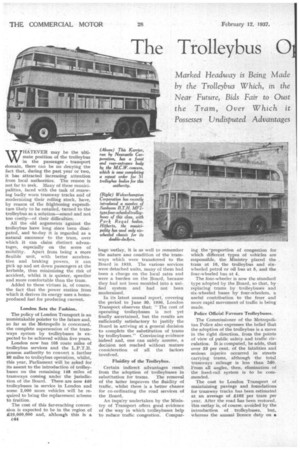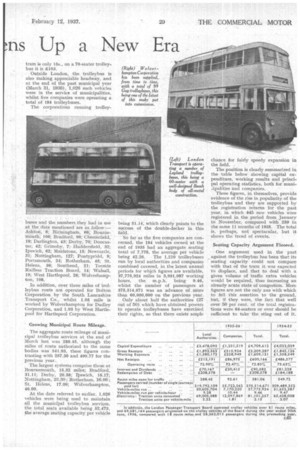The Trolleybus ris Up a ew Era
Page 94

Page 95

If you've noticed an error in this article please click here to report it so we can fix it.
Marked Headway is Being Made by the Trolleybus Which, in the Near Future, Bids Fair to Oust the Tram, Over Which it Possesses Undisputed Advantages
WHATEVER may be the ultimate position of the trolleybus in the passenger transport domain, there can be no denying the fact that, during the past year or two, it has attracted increasing attention from local authorities. The reason is not far to seek. Many of these municipalities, faced with the -task of renewing badly worn tramway tracks and of modernizing their rolling stock, have, by reason of the frightening expenditure likely to be entailed, •turned to the trolleybus as a solution—sound and not too costly—of their difficulties.
All the old arguments against the trolleybus have long since been dissipated, and to-day it is regarded as a natural successor to the tram, over which it ran claini distinct advantages, especially on the score of mobility. Apart from being a more flexible unit, with better accelerative and braking powers, it can pick up and set down passengers at the kerbside, thus minimizing the risk of accident, whilst it is quieter, speedier and more comfortable than the tram.
Added to these virtues is, of course, the fact that the power station from which it derives its energy uses a homeproduced fuel for producing current.
London Sets the Fashion.
The policy of London Transport is an unmistakable pointer to the future and, so far as the Metropolis is concerned, the complete supersession of the tramways system by trolleybuses is expected to be achieved within five years.
London now has 105 route miles of trolleybus services and the L.P.T.B. possess authority to convert a further 80 miles to trolleybus operation, whilst, this year, Parliament will be asked for its assent to the introduction of trolleybuses on the remaining 148 miles of tramways coming under the jurisdiction of the Board. There are now 440 trolleybuses in service in London and some 2,000 more vehicles will be required to bring the replacement scheme to fruition.
The cost of this far-reaching converthon is expected to be in the region of .i.o,000,000 and, although this is a e44
huge outlay, it is as well to remember the nature and condition of the tramways which were transferred to the Board in 1933. The various services were detached units, many of them had been a charge on the local rates and were a 'burden on the Board, because they bad not been moulded into a unified system and had not been modernized.
In its latest annual report, covering the period to June 30, 1938, London Transport observes that: "The cost of operating trolleybuses is not yet finally ascertained, but the results are Sufficiently satisfactory to justify the Board in arriving at a general decision to complete the substitution of trams by trolleybuses." Convincing evidence indeed and, one can safely assume, a decision not reached without mature consideration of all the factors involved.
Fluidity of the Trolleybus.
Certain indirect advantages result from the adoption of trolleybuses in substitution for trams. The removal of the latter improves the fluidity of traffic, whilst there is a better chance for co-ordinating the road services of the Board.
An inquiry undertaken by the Ministry of Transport offers good evidence of the way in which trolleybuses help to reduce traffic congestion. Compar
ing the 'proportion of congestion for which different types of vehicles are responsible, the Ministry placed the tram at 10, the trolleybus and sixwheeled petrol or oil bus at 5, and the four-wheeled bus at 4.
The four-wheeler is now the standard type adopted by the Board, so that, by • replacing trains by trolleybuses and six-wheeled buses by four-wheelers, a useful contribution to the freer and more rapid movement of traffic is being made.
Police Official Favours Trolleybuses.
The Commissioner of the Metropolitan Police also expresses the belief that the adoption of the trolleybus is a move in the right direction, from the points of view of public safety and traffic circulation. It is computed, he adds, that over 33 per cent, of the fatalities and serious injuries occurred in streets carrying trams, although the total tramways mileage is less than 340. From all angles, then, elimination of the fixed-rail system is te be commended.
The cost to London Transport of maintaining pavings and foundations for tramway tracks has been estimated at an average of 102 per tram per year. After the road has been restored, this outlay is, of course, avoided by the introduction of trolleybuses, but, whereas the annual licence duty on a
tram is only 15s., on a 70-seater trolleybus it is £103.
Outside London, the trolleybus is also making appreciable headway, and at the end of the past municipal year (March 31, 1938), 1,028 such vehicles were in the service of municipalities, whilst five companies were operating a total of 184 trolleybuses.
The corporations running trolley buses and the numbers they had in use at the date mentioned are as follow:— Ashton, 8; Birminghain, 66; Bournemouth, 106; Bradford, 96; Chesterfield, 19; Darlington, 43; Derby, 70; Doncaster, 42; Grimsby, 7; Huddersfield, 32; Ipswich, 62; Maidstone, 15; Newcastle, 31; Nottingham, 127; Pontypridd, 9; Portsmouth, 24; Rotherham, 45; St. Helens, 36; Southend, 21; Teesicle Railless Traction Board, 14; Walsall, 19; West Hartlepool, 26; Wolverhampton, 108.
In addition, over three miles of trolleybus route are operated for Bolton Corporation by the South Lancashire Transport Co., whilst 1.05 mile is worked by Wolverhampton for Dudley Corporation, and 1.93 by West Hartlepool for Hartlepool Corporation.
Growing Municipal Route Mileage.
The aggregate route mileage of municipal trolleybus services at the end of March last was 288.45, although the miles of route authorized to the same bodies was 541.93, these figures contrasting with 257.30 and 490.77 for the previous year.
The largest systems comprise those at Bournemouth, 15.32 miles; Bradford, 31.11; Derby, 20.58;. Tpswich, 16.17; Nottingham, 23.30; Rotherham, 16.06; St. Helena, 17.09; Wolverhampton, 46.09.
At the date referred to earlier, 1,026 vehicles were being used to maintain all the municipal trolleybus services, the tbtal seats available being 52,473, the average Seating capacity per vehicle being 51.14; which clearly points to the success of the doable-decker in this field.
So far as the five companies are concerned, the 184 vehicles owned at the end of 1935 had an aggregate seating total of 7,775, the average per vehicle being 42.26. The 1,210 trolleybuses run by local authorities and companies combined covered, in the latest annual periods for which figures are available, 37,775,924 miles in 3,991,087 working hours, the m.p.h. being 9.46, whilst the number of passengers at 375,514,671 was an advance of more than 60,000,000 on the previous year.
Only about half the authorities (27 out of 50) which have obtained powers to operate trolleybuses have exercised their rights, so that there exists ample chance for fairly speedy expansion in the field.
The position is clearly summarized in the table below showing capital expenditure, working results and principal operating statistics, both for munizipalities and companies.
These figures, in themselves, provide evidence of the rise in popularity of the trolleybus and they are supported by the registration returns for the past year, in which 445 new vehicles were registered in the period from January to November, compared with 259 in the same 11 months of 1935. The total is, perhaps, not spectacular, but it shows the trend of events.
Seating Capacity Argument Floored.
One argument used in the past against the trolleybus has been that its seating capacity could not compare with that of the tram it was expected to displace, and that to deal with a given volume of traffic extra vehicles would be required, thus increasing an already acute state of congestion. Mere figures are not the only axe with which to fell this assertion to the ground, but, if they were, the fact that well over 50 per cent. of the total registrations were 64-seaters or over should be sufficient to take the sting out of it.




























































































































































